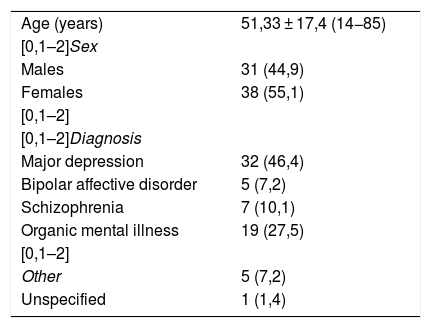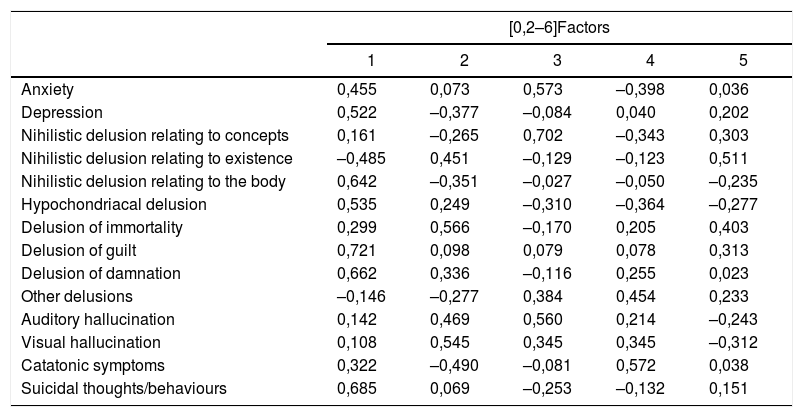Cotard’s syndrome is a rare psychiatric condition. As a result, current information is mainly based on reports and case series.
ObjectiveTo analyse the psychopathological characteristics and the grouping of the symptoms of the Cotard’s syndrome cases reported in the medical literature.
MethodsA systematic review of the literature of all reported cases of Cotard’s syndrome from 2005 to January 2018 was performed in the MEDLINE/PubMed database. Demographic variables and clinical characteristics of each case were collected. An exploratory factor analysis of the symptoms was performed.
ResultsThe search identified 86 articles, of which 69 were potentially relevant. After reviewing the full texts, 55 articles were selected for the systematic review, in which we found 69 cases. We found that the diagnosis of major depression (P < 0.001) and organic mental disorder (P = 0.004) were more frequent in the older group with Cotard’s syndrome. An exploratory factor analysis extracted 3 factors: psychotic depression, in which it includes patients with delusions of guilt (0.721), suicidal ideas (0.685), delusions of damnation (0.662), nihilistic delusions of the body (0.642), depression (0.522), and hypochondriacal delusions (0.535); delusive-hallucinatory, with patients who presented delusions of immortality (0.566), visual hallucinations (0.545) and nihilistic delusions of existence (0.451), and mixed, with patients who presented nihilistic delusions of concepts (0.702), anxiety (0.573), and auditory hallucinations (0.560).
ConclusionsThe psychopathology of Cotard’s syndrome is more complex than the simple association with the delusion of being dead, since it encompasses a factorial structure organised into 3 factors.
El síndrome de Cotard es de rara aparición en la clínica psiquiátrica. Debido a esto, la información actual se basa principalmente en reportes y series de casos.
ObjetivoAnalizar las características psicopatológicas y la agrupación de los síntomas de los casos de síndrome de Cotard reportados en la literatura médica.
MétodosSe realizó en la base de datos MEDLINE/PubMed una búsqueda sistemática de la literatura de todos los casos de síndrome de Cotard reportados desde 2005 hasta enero de 2018. Se recolectaron variables demográficas y las características clínicas de cada caso. Se realizó un análisis factorial exploratorio de los síntomas.
ResultadosLa búsqueda identificó 86 artículos, de los cuales 69 eran potencialmente relevantes. Luego de la revisión de los textos completos, se seleccionaron 55 artículos para la revisión sistemática, entre los cuales se hallaron 69 casos. En el grupo de más edad con síndrome de Cotard fueron más frecuentes los diagnósticos de depresión mayor (p < 0,001) y trastorno mental orgánico (p = 0,004). El análisis factorial exploratorio arrojó 3 factores: depresión psicótica, en la que se incluye a los pacientes con delirios de culpa (0,721), ideas suicidas (0,685), delirios de condena (0,662), delirio nihilista del cuerpo (0,642), depresión (0,522) y delirios hipocondriacos (0,535); delirante-alucinatorio, con pacientes que sufrían delirio de inmortalidad (0,566), alucinaciones visuales (0,545) y delirio nihilista de la existencia (0,451), y mixto, con pacientes que sufrían delirio nihilista de los conceptos (0,702), ansiedad (0,573) y alucinaciones auditivas (0,560).
ConclusionesLa psicopatología del síndrome de Cotard es más compleja que la simple asociación con el delirio de estar muerto, ya que abarca una estructura factorial organizada en 3 factores.









